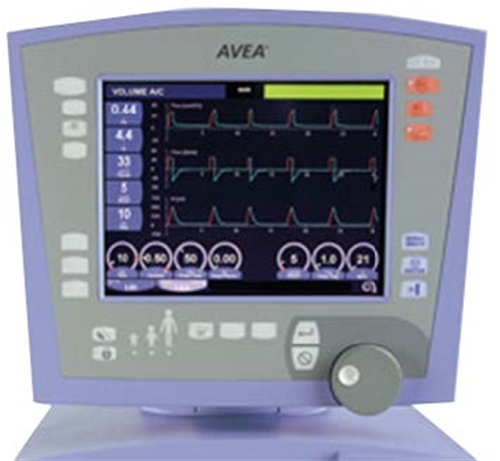Vyaire CareFusion Avea Ventilator
November 15, 2017
Vyaire CareFusion Avea Features
The Vyaire CareFusion Avea ventilator provides comprehensive critical care ventilation for the smallest patients in the NICU to children and adults with complex respiratory diseases. The Vyaire AVEA ventilator provides invasive and noninvasive ventilation for all patients types, Volumetric Capnography and Transpulmonary Pressure Monitoring, but also has the capability to bring clinicians and hospital management actionable information to help better address clinical and operational challenges in patient care.
The Viasys AVEA respirator comprehensive ventilator has integrated BiCoreTM technology for advanced pulmonary monitoring. Front panel connection ports are provided for esophageal balloon catheters, tracheal catheters and proximal low sensors. Heliox administration, Pflex, nCPAP and the unique scroll pump compressor come as standard features.
- Automated MIP/NIF, AutoPEEP and Slow Flow maneuvers
- Programmable oxygen increase
- Artificial airway compensation
- Leak compensation
- Comprehensive array of modes and advanced features:
- Volumetric capnography
- Precision gas delivery system
- On-board compressor
- Three different serial communication protocols
BD CareFusion Avea Specifications
Setup
- Humidifier: Active and passive humidification
- Circuit compliance compensation: 0.0 to 7.5 mL/cmH2O
- Leak compensation: ON, OFF
Endotracheal Tube Setup
- Diameter: 2.0 to 10.0 mm
- Length: 2.0 to 30.0 cm
- Automatic tube compensation: ON, OFF
Patient Setup
- Patient weight: 0.1 to 300 kg
- Patient ID: Alphanumeric 24 characters
Mode
- Mode type: A/C, SIMV, CPAP/PSV, NPPV, nasal CPAP/IMV
- Breath type: APRV/BiPhasic,Volume, Pressure, TCPL, PRVC,Volume Guarantee
- Apnea backup: Volume, pressure
Primary Settings
- Rate: 1 to 150 bpm (neonatal, pediatric), 1 to 120 bpm (adult)
- Tidal volume: 2.0 mL to 2.5 L
- Inspiratory pressure: 0 to 80 cmH2O (neonatal), 0 to 90 cmH2O (adult, pediatric)
- Peak flow: 0.4 to 150 L/min
- Inspiratory time: 0.15 to 5.0 sec
- Pressure support ventilation: 0 to 80 cmH2O (neonatal), 0 to 90 cmH2O (adult, pediatric)
- PEEP: 0 to 50 cmH2O
- Flow trigger: 0.1 to 20 L/min
- %O2: 21% to 100%
- Pressure high (in APRV mode): 0 to 90 cmH2O
- Time high (in APRV mode): 0.2 to 30 sec
- Time low (in APRV mode): 0.2 to 30 sec
- Pressure low (in APRV mode): 0 to 45 cmH2O
Advanced Settings
- Bias flow: 0.4 to 5.0 L/min
- Volume limit: 2.0 mL to 2.5 L
- Inspiratory rise: 1 to 9
- Flow cycle: Off to 45%
- PSV rise: 1 to 9
- PSV cycle: 5% to 45%
- PSV Tmax: 0.15 to 5.0 sec
- Waveform: Decelerating, square
- Sigh: ON, OFF
- Pressure trigge:r 0.1 to 20 cmH2O
- Demand flow: ON, OFF
- Volumetric capnography: EtCO2 averaging 1 or 8 breaths, VCO2 averaging 3, 6, 9 or 12 minutes
Manual Controls
- Manual breath: One breath
- Expiratory hold: Maximum 20 sec (adult, pediatric), 3 sec (neonatal)
- Inspiratory hold: Maximum 3 seconds
- Increase O2: Set percentage O2 + 0% to 79% O2
- Synchronized nebulizer: Available when peak flow > 15 L/min
- Disconnect for suction: Active
Alarms
- Vent inop Ventilator inoperative
- Loss of gas All gas sources lost
- Circuit disconnect Patient circuit disconnected
- Ext. high Ppeak High Ppeak longer than 5 seconds
- Safety valve Safety valve open
- Circuit occlusion Circuit occlusion
- High Ppeak High peak pressure
- Apnea interval Apnea interval exceeded
- Loss of O2 Oxygen supply lost
- Loss of air Air supply lost
- Loss of heliox Heliox supply lost
- Low battery Internal/external batteries low
- Loss of A/C Main AC power lost
- Low PEEP Low PEEP cmH2O
- Low Ppeak Low PIP cmH2O
- Low Vte Low tidal volume
- Low Ve Low minute volume
- Low %O2 Low FiO2 reading
- High %O2 High FiO2 reading
- ILV disconnect Independent lung ventilation lost
- Alarm test Test alarm/set loudness
- Invalid gas ID Gas type ID bad or missing
- High Ve High minute volume
- High rate High breath rate
- Max insp time Inspiratory time limit exceeded
- I:E limit I:E ratio limit exceeded
- Fan failure Cooling fan failure
- High Vt High tidal volume
- Vol limit Volume limit exceeded
- Low EtCO 3 2 Low end tidal CO2
- High EtCO 3 2 High end tidal CO2
- nCPAP pressure limit nCPAP pressure limit exceeded
- Low nCPAP pressure Low nCPAP cmH2O
- High nCPAP pressure High nCPAP cmH2O
Advanced Patient Monitoring
- Proximal hot wire flow sensor
- Proximal variable orifice flow sensor (infant, pediatric, adult)
- Proximal airway pressure monitoring
- Tracheal pressure monitoring
- Esophageal pressure monitoring
- Volumetric capnography
Have you used this product? Do you like or dislike using it?
Explore Other Blog Items By Category
Recent Posts


Surgical Microscope Rentals

